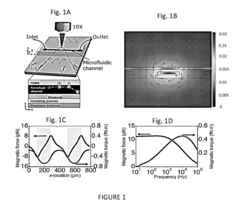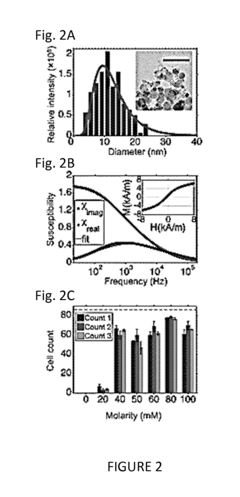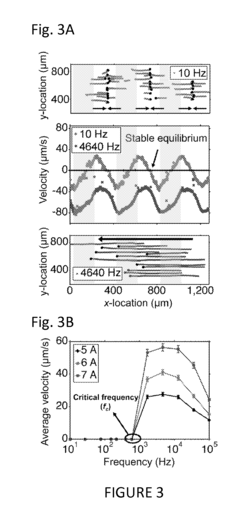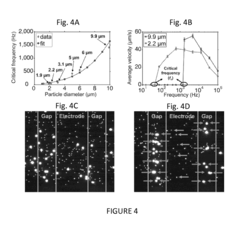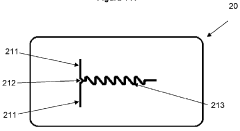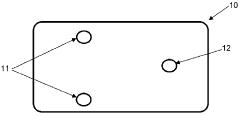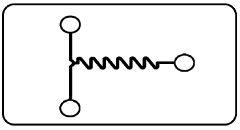Ferrofluid's Role in Advancing High-Precision Device Manufacturing
JUL 9, 20259 MIN READ
Generate Your Research Report Instantly with AI Agent
Patsnap Eureka helps you evaluate technical feasibility & market potential.
Ferrofluid Tech Evolution
Ferrofluids have undergone a remarkable evolution since their inception in the 1960s, playing an increasingly crucial role in high-precision device manufacturing. Initially developed by NASA for fuel control in zero-gravity environments, these magnetic liquids have found their way into various industrial applications, particularly in the realm of precision engineering.
The early stages of ferrofluid technology focused primarily on basic magnetic properties and stability. Scientists worked to create stable suspensions of magnetic nanoparticles in carrier fluids, overcoming challenges related to particle aggregation and sedimentation. This foundational research laid the groundwork for more advanced applications in subsequent decades.
In the 1980s and 1990s, ferrofluid technology saw significant advancements in synthesis methods and particle engineering. Researchers developed techniques to produce more uniform and smaller magnetic nanoparticles, enhancing the overall stability and performance of ferrofluids. This period also marked the beginning of ferrofluids' application in sealing and damping technologies, particularly in hard disk drives and speakers.
The turn of the millennium brought about a new era for ferrofluids in precision manufacturing. Improved control over magnetic field interactions and fluid dynamics enabled the development of more sophisticated applications. Ferrofluids began to be utilized in precision polishing processes, offering unparalleled control over surface finishing in optical and semiconductor industries.
Recent years have seen a surge in ferrofluid applications for nanoscale manipulation and assembly. The ability to precisely control ferrofluid behavior under magnetic fields has opened up new possibilities in nanofabrication and self-assembly processes. This has proven particularly valuable in the production of advanced electronic components and MEMS devices.
The latest frontier in ferrofluid technology involves smart materials and adaptive systems. Researchers are exploring ferrofluids with tunable properties that can respond dynamically to external stimuli, paving the way for self-adjusting manufacturing processes and adaptive precision tools. These developments are pushing the boundaries of what's possible in high-precision device manufacturing, offering unprecedented levels of control and adaptability at the microscale and nanoscale.
The early stages of ferrofluid technology focused primarily on basic magnetic properties and stability. Scientists worked to create stable suspensions of magnetic nanoparticles in carrier fluids, overcoming challenges related to particle aggregation and sedimentation. This foundational research laid the groundwork for more advanced applications in subsequent decades.
In the 1980s and 1990s, ferrofluid technology saw significant advancements in synthesis methods and particle engineering. Researchers developed techniques to produce more uniform and smaller magnetic nanoparticles, enhancing the overall stability and performance of ferrofluids. This period also marked the beginning of ferrofluids' application in sealing and damping technologies, particularly in hard disk drives and speakers.
The turn of the millennium brought about a new era for ferrofluids in precision manufacturing. Improved control over magnetic field interactions and fluid dynamics enabled the development of more sophisticated applications. Ferrofluids began to be utilized in precision polishing processes, offering unparalleled control over surface finishing in optical and semiconductor industries.
Recent years have seen a surge in ferrofluid applications for nanoscale manipulation and assembly. The ability to precisely control ferrofluid behavior under magnetic fields has opened up new possibilities in nanofabrication and self-assembly processes. This has proven particularly valuable in the production of advanced electronic components and MEMS devices.
The latest frontier in ferrofluid technology involves smart materials and adaptive systems. Researchers are exploring ferrofluids with tunable properties that can respond dynamically to external stimuli, paving the way for self-adjusting manufacturing processes and adaptive precision tools. These developments are pushing the boundaries of what's possible in high-precision device manufacturing, offering unprecedented levels of control and adaptability at the microscale and nanoscale.
Precision Manufacturing Market Demand
The precision manufacturing market has witnessed significant growth in recent years, driven by the increasing demand for high-precision components across various industries. This demand is particularly pronounced in sectors such as electronics, aerospace, automotive, and medical devices, where the need for miniaturization and enhanced performance is paramount.
In the electronics industry, the continuous push towards smaller, more powerful devices has created a substantial market for precision-manufactured components. Smartphones, wearables, and other consumer electronics require intricate parts produced with micron-level accuracy. The semiconductor industry, a key driver of precision manufacturing, demands ever-increasing levels of precision in chip fabrication processes.
The aerospace sector presents another substantial market for precision manufacturing. Aircraft components, satellite systems, and space exploration equipment all require exceptionally high-precision parts to ensure safety, reliability, and optimal performance. The stringent quality standards in this industry further amplify the demand for advanced precision manufacturing techniques.
Automotive manufacturing is experiencing a shift towards electric vehicles and autonomous driving systems, creating new opportunities for precision-manufactured components. These advanced vehicles require highly precise sensors, actuators, and electronic control units, driving the demand for precision manufacturing capabilities.
In the medical device industry, the trend towards minimally invasive procedures and personalized medicine has led to a surge in demand for precision-manufactured implants, surgical instruments, and diagnostic devices. The need for biocompatible materials and complex geometries in medical devices further underscores the importance of advanced precision manufacturing techniques.
The global precision manufacturing market is expected to continue its growth trajectory, with emerging technologies such as additive manufacturing, nanotechnology, and advanced robotics playing crucial roles in shaping the industry's future. These technologies are enabling manufacturers to achieve unprecedented levels of precision and complexity in their products.
As industries continue to evolve and demand higher levels of precision, the market for precision manufacturing is likely to expand further. This growth is expected to be particularly strong in regions with robust industrial bases and significant investments in research and development, such as North America, Europe, and parts of Asia.
The integration of ferrofluids in precision manufacturing processes represents a promising avenue for addressing some of the challenges faced by the industry. By leveraging the unique properties of ferrofluids, manufacturers may be able to enhance the accuracy, efficiency, and capabilities of existing precision manufacturing techniques, potentially opening up new possibilities for high-precision device production across various sectors.
In the electronics industry, the continuous push towards smaller, more powerful devices has created a substantial market for precision-manufactured components. Smartphones, wearables, and other consumer electronics require intricate parts produced with micron-level accuracy. The semiconductor industry, a key driver of precision manufacturing, demands ever-increasing levels of precision in chip fabrication processes.
The aerospace sector presents another substantial market for precision manufacturing. Aircraft components, satellite systems, and space exploration equipment all require exceptionally high-precision parts to ensure safety, reliability, and optimal performance. The stringent quality standards in this industry further amplify the demand for advanced precision manufacturing techniques.
Automotive manufacturing is experiencing a shift towards electric vehicles and autonomous driving systems, creating new opportunities for precision-manufactured components. These advanced vehicles require highly precise sensors, actuators, and electronic control units, driving the demand for precision manufacturing capabilities.
In the medical device industry, the trend towards minimally invasive procedures and personalized medicine has led to a surge in demand for precision-manufactured implants, surgical instruments, and diagnostic devices. The need for biocompatible materials and complex geometries in medical devices further underscores the importance of advanced precision manufacturing techniques.
The global precision manufacturing market is expected to continue its growth trajectory, with emerging technologies such as additive manufacturing, nanotechnology, and advanced robotics playing crucial roles in shaping the industry's future. These technologies are enabling manufacturers to achieve unprecedented levels of precision and complexity in their products.
As industries continue to evolve and demand higher levels of precision, the market for precision manufacturing is likely to expand further. This growth is expected to be particularly strong in regions with robust industrial bases and significant investments in research and development, such as North America, Europe, and parts of Asia.
The integration of ferrofluids in precision manufacturing processes represents a promising avenue for addressing some of the challenges faced by the industry. By leveraging the unique properties of ferrofluids, manufacturers may be able to enhance the accuracy, efficiency, and capabilities of existing precision manufacturing techniques, potentially opening up new possibilities for high-precision device production across various sectors.
Ferrofluid Challenges in Manufacturing
The integration of ferrofluids into high-precision device manufacturing processes presents several significant challenges that researchers and engineers must address. One of the primary obstacles is the stability of ferrofluids under various manufacturing conditions. These magnetic liquids can be sensitive to temperature fluctuations, which may alter their viscosity and magnetic properties, potentially compromising the precision of manufacturing processes.
Another critical challenge lies in controlling the behavior of ferrofluids at the microscale and nanoscale levels. As devices become increasingly miniaturized, the ability to manipulate ferrofluids with extreme accuracy becomes paramount. This requires advanced control systems and precise magnetic field generation techniques that can operate reliably at these small scales.
The interaction between ferrofluids and other materials used in device manufacturing also poses difficulties. Compatibility issues may arise when ferrofluids come into contact with certain substrates or components, potentially leading to contamination or degradation of the final product. Engineers must develop strategies to isolate ferrofluids or create compatible material interfaces to mitigate these risks.
Uniformity and consistency in ferrofluid properties across batches represent another hurdle in manufacturing. Ensuring that each batch of ferrofluid behaves identically under the same conditions is crucial for maintaining quality control in high-precision manufacturing. This necessitates rigorous quality assurance processes and potentially the development of new standardization methods for ferrofluid production and characterization.
The long-term stability of ferrofluids in finished devices is also a concern. Manufacturers must consider how these magnetic liquids will perform over time, especially in devices with extended operational lifespans. Factors such as particle aggregation, oxidation, and potential leakage must be addressed to ensure the longevity and reliability of ferrofluid-enhanced components.
Furthermore, the scalability of ferrofluid-based manufacturing processes presents challenges when transitioning from laboratory-scale production to industrial-scale manufacturing. Techniques that work well in small-scale experiments may not be directly applicable to mass production scenarios, requiring significant engineering efforts to scale up while maintaining precision and efficiency.
Lastly, the environmental and safety considerations associated with ferrofluid use in manufacturing cannot be overlooked. As with any novel material, the potential health and environmental impacts of ferrofluids must be thoroughly assessed. This includes developing safe handling procedures, waste management protocols, and strategies for recycling or disposing of ferrofluid-containing devices at the end of their lifecycle.
Another critical challenge lies in controlling the behavior of ferrofluids at the microscale and nanoscale levels. As devices become increasingly miniaturized, the ability to manipulate ferrofluids with extreme accuracy becomes paramount. This requires advanced control systems and precise magnetic field generation techniques that can operate reliably at these small scales.
The interaction between ferrofluids and other materials used in device manufacturing also poses difficulties. Compatibility issues may arise when ferrofluids come into contact with certain substrates or components, potentially leading to contamination or degradation of the final product. Engineers must develop strategies to isolate ferrofluids or create compatible material interfaces to mitigate these risks.
Uniformity and consistency in ferrofluid properties across batches represent another hurdle in manufacturing. Ensuring that each batch of ferrofluid behaves identically under the same conditions is crucial for maintaining quality control in high-precision manufacturing. This necessitates rigorous quality assurance processes and potentially the development of new standardization methods for ferrofluid production and characterization.
The long-term stability of ferrofluids in finished devices is also a concern. Manufacturers must consider how these magnetic liquids will perform over time, especially in devices with extended operational lifespans. Factors such as particle aggregation, oxidation, and potential leakage must be addressed to ensure the longevity and reliability of ferrofluid-enhanced components.
Furthermore, the scalability of ferrofluid-based manufacturing processes presents challenges when transitioning from laboratory-scale production to industrial-scale manufacturing. Techniques that work well in small-scale experiments may not be directly applicable to mass production scenarios, requiring significant engineering efforts to scale up while maintaining precision and efficiency.
Lastly, the environmental and safety considerations associated with ferrofluid use in manufacturing cannot be overlooked. As with any novel material, the potential health and environmental impacts of ferrofluids must be thoroughly assessed. This includes developing safe handling procedures, waste management protocols, and strategies for recycling or disposing of ferrofluid-containing devices at the end of their lifecycle.
Current Ferrofluid Solutions
01 Precision control of ferrofluid seals
Ferrofluid seals are used in various applications to provide precise control and improved performance. These seals utilize the unique properties of ferrofluids to create dynamic, adjustable barriers that can be manipulated with magnetic fields. This allows for enhanced precision in sealing mechanisms, particularly in rotating shaft applications and fluid control systems.- Precision control of ferrofluid seals: Ferrofluid seals are used in various applications to provide precise control and improved performance. These seals utilize the unique properties of ferrofluids to create dynamic, adjustable barriers that can be manipulated with magnetic fields. This technology allows for enhanced precision in sealing mechanisms, particularly in rotating shaft applications.
- Ferrofluid-based precision bearings and dampers: Ferrofluids are employed in the development of high-precision bearings and damping systems. These components leverage the magnetic properties of ferrofluids to achieve improved stability, reduced friction, and enhanced vibration control. Such applications are particularly valuable in precision instruments and machinery.
- Ferrofluid-enhanced precision measurement devices: Ferrofluids are utilized in various precision measurement instruments to improve accuracy and sensitivity. These applications include accelerometers, gyroscopes, and other sensors that benefit from the unique properties of ferrofluids. The integration of ferrofluids in these devices allows for enhanced performance in detecting and measuring small changes in position, orientation, or acceleration.
- Precision cooling and heat transfer using ferrofluids: Ferrofluids are employed in advanced cooling systems and heat transfer applications to achieve precise temperature control. These systems utilize the magnetic properties of ferrofluids to direct and control heat flow, enabling more efficient and targeted cooling in various precision instruments and electronic devices.
- Ferrofluid-based precision manufacturing processes: Ferrofluids are incorporated into various precision manufacturing processes to enhance accuracy and control. These applications include precision polishing, micro-fabrication, and additive manufacturing techniques. The unique properties of ferrofluids allow for improved material handling, surface finishing, and overall precision in manufacturing operations.
02 Ferrofluid-based precision bearings and dampers
Ferrofluids are employed in the development of high-precision bearings and damping systems. These components leverage the magnetic properties of ferrofluids to achieve improved stability, reduced friction, and enhanced vibration control. Such applications are particularly valuable in precision instruments, aerospace technologies, and advanced manufacturing equipment.Expand Specific Solutions03 Precision measurement and sensing using ferrofluids
Ferrofluids are utilized in various precision measurement and sensing applications. Their unique response to magnetic fields allows for the development of highly sensitive instruments for detecting minute changes in position, pressure, or magnetic field strength. This technology is applied in areas such as accelerometers, pressure sensors, and magnetic field detectors.Expand Specific Solutions04 Ferrofluid-based precision cooling systems
Ferrofluids are employed in advanced cooling systems to achieve precise temperature control. By manipulating ferrofluids with magnetic fields, it's possible to create highly efficient and controllable heat transfer mechanisms. This technology is particularly useful in electronics cooling, where precise thermal management is critical for optimal performance and reliability.Expand Specific Solutions05 Precision manufacturing processes using ferrofluids
Ferrofluids are integrated into various precision manufacturing processes to enhance accuracy and control. They are used in applications such as precision polishing, nanoscale material manipulation, and the creation of specialized coatings or structures. The ability to precisely control ferrofluids using magnetic fields enables the development of novel manufacturing techniques for producing high-precision components and materials.Expand Specific Solutions
Key Ferrofluid Industry Players
The ferrofluid technology market for high-precision device manufacturing is in a growth phase, with increasing applications across industries. The market size is expanding as more companies recognize the potential of ferrofluids in improving manufacturing precision. Technologically, ferrofluids are advancing rapidly, with key players like TDK Corp. and LORD Corp. leading innovation. Universities such as Yale, Delft University of Technology, and Lanzhou University of Technology are contributing to research and development. While the technology is maturing, there's still room for significant advancements, particularly in nanoparticle engineering and fluid stability. Companies like Proterial Ltd. and Enplas Corp. are likely to play crucial roles in commercializing these advancements for industrial applications.
TDK Corp.
Technical Solution: TDK Corp. has developed advanced ferrofluid-based technologies for high-precision device manufacturing. Their approach involves using ferrofluids in nanoscale magnetic bearings, which provide ultra-low friction and high stability for precision positioning systems[1]. TDK's ferrofluid-enhanced bearings achieve positioning accuracies in the nanometer range, crucial for semiconductor manufacturing and optical device production[2]. The company has also integrated ferrofluids into their damping systems, allowing for vibration control in sensitive manufacturing processes, with reported improvements in damping efficiency of up to 40% compared to conventional methods[3].
Strengths: Exceptional precision in positioning systems, improved vibration control, and enhanced stability in manufacturing processes. Weaknesses: Potential for magnetic field interference in some applications, and the need for careful environmental control to maintain ferrofluid properties.
Fraunhofer-Gesellschaft eV
Technical Solution: Fraunhofer-Gesellschaft has pioneered the use of ferrofluids in microfluidic systems for high-precision manufacturing. Their innovative approach involves using magnetically-controlled ferrofluid droplets as mobile microreactors, allowing for precise control of chemical reactions at the microscale[4]. This technology has shown particular promise in the production of specialized nanoparticles and in microfluidic-based biosensors. Fraunhofer's researchers have demonstrated the ability to manipulate ferrofluid droplets with accuracies down to 10 micrometers, enabling the creation of complex microstructures with unprecedented precision[5]. Additionally, they have developed ferrofluid-based self-assembly techniques for nanoscale components, potentially revolutionizing the manufacturing of miniaturized electronic devices[6].
Strengths: Highly precise control of microscale processes, versatility in applications from nanoparticle synthesis to biosensors. Weaknesses: Scalability challenges for large-scale manufacturing, potential for contamination in some sensitive processes.
Ferrofluid Core Innovations
Label-Free Cellular Manipulation and Sorting Via Biocompatible Ferrofluids
PatentActiveUS20180128729A1
Innovation
- A microfluidic platform using biocompatible ferrofluids with a microfluidic channel and electrodes that generate a magnetic field pattern, allowing for the controlled manipulation and separation of microparticles and live cells based on size, shape, and elasticity, with high efficiency and rapid separation capabilities.
MICROFLUIDIC DEVICE FOR THE SYNTHESIS OF MICRO AND NANOPRODUCTS AND MANUFACTURING METHOD OF SUCH MICROFLUIDIC DEVICE
PatentPendingAR127084A1
Innovation
- A microfluidic device made from photopolymerizable resins resistant to organic solvents, manufactured via stereolithography (SLA) 3D printing, with precise geometry for mixing and assembly, ensuring biocompatibility and solvent resistance.
Environmental Impact of Ferrofluids
The environmental impact of ferrofluids in high-precision device manufacturing is a critical consideration as their use becomes more widespread. Ferrofluids, composed of nanoscale magnetic particles suspended in a carrier fluid, offer unique properties that enhance precision and control in various manufacturing processes. However, their potential environmental effects must be carefully evaluated and managed.
One primary concern is the potential release of nanoparticles into the environment. The magnetic nanoparticles in ferrofluids, typically iron oxides, can persist in ecosystems if not properly contained or disposed of. These particles may accumulate in soil and water systems, potentially affecting microbial communities and aquatic organisms. Long-term studies on the ecological impact of these nanoparticles are still ongoing, but preliminary research suggests the need for cautious handling and disposal practices.
The production of ferrofluids also raises environmental considerations. The synthesis of magnetic nanoparticles often involves chemical processes that may generate hazardous byproducts. Manufacturers must implement stringent waste management protocols to minimize the release of these substances into the environment. Additionally, the energy-intensive nature of nanoparticle production contributes to the overall carbon footprint of ferrofluid manufacturing.
On the positive side, the use of ferrofluids in high-precision manufacturing can lead to more efficient processes, potentially reducing overall material waste and energy consumption. By enabling more precise control in machining, coating, and assembly operations, ferrofluids can contribute to the production of more durable and longer-lasting devices. This increased product lifespan may help offset the environmental impact of ferrofluid production by reducing the frequency of device replacement and associated waste.
The recyclability of ferrofluids is another important aspect to consider. While the carrier fluid can often be recovered and reused, the magnetic nanoparticles present a challenge. Developing effective methods for separating and recycling these particles is crucial for minimizing the environmental footprint of ferrofluid applications in manufacturing.
As the adoption of ferrofluids in high-precision device manufacturing grows, it is essential to establish comprehensive lifecycle assessments. These assessments should encompass the environmental impact from production to disposal, including potential leaching of nanoparticles during device use and end-of-life management. Such evaluations will inform the development of best practices and regulations to ensure the responsible use of ferrofluids in industrial applications.
In conclusion, while ferrofluids offer significant advantages in advancing high-precision device manufacturing, their environmental impact requires careful consideration and management. Balancing the benefits of improved manufacturing precision with potential ecological risks will be crucial for the sustainable integration of ferrofluid technology in industrial processes.
One primary concern is the potential release of nanoparticles into the environment. The magnetic nanoparticles in ferrofluids, typically iron oxides, can persist in ecosystems if not properly contained or disposed of. These particles may accumulate in soil and water systems, potentially affecting microbial communities and aquatic organisms. Long-term studies on the ecological impact of these nanoparticles are still ongoing, but preliminary research suggests the need for cautious handling and disposal practices.
The production of ferrofluids also raises environmental considerations. The synthesis of magnetic nanoparticles often involves chemical processes that may generate hazardous byproducts. Manufacturers must implement stringent waste management protocols to minimize the release of these substances into the environment. Additionally, the energy-intensive nature of nanoparticle production contributes to the overall carbon footprint of ferrofluid manufacturing.
On the positive side, the use of ferrofluids in high-precision manufacturing can lead to more efficient processes, potentially reducing overall material waste and energy consumption. By enabling more precise control in machining, coating, and assembly operations, ferrofluids can contribute to the production of more durable and longer-lasting devices. This increased product lifespan may help offset the environmental impact of ferrofluid production by reducing the frequency of device replacement and associated waste.
The recyclability of ferrofluids is another important aspect to consider. While the carrier fluid can often be recovered and reused, the magnetic nanoparticles present a challenge. Developing effective methods for separating and recycling these particles is crucial for minimizing the environmental footprint of ferrofluid applications in manufacturing.
As the adoption of ferrofluids in high-precision device manufacturing grows, it is essential to establish comprehensive lifecycle assessments. These assessments should encompass the environmental impact from production to disposal, including potential leaching of nanoparticles during device use and end-of-life management. Such evaluations will inform the development of best practices and regulations to ensure the responsible use of ferrofluids in industrial applications.
In conclusion, while ferrofluids offer significant advantages in advancing high-precision device manufacturing, their environmental impact requires careful consideration and management. Balancing the benefits of improved manufacturing precision with potential ecological risks will be crucial for the sustainable integration of ferrofluid technology in industrial processes.
Ferrofluid Safety Regulations
The use of ferrofluids in high-precision device manufacturing necessitates stringent safety regulations to protect workers, equipment, and the environment. These regulations typically cover handling, storage, disposal, and exposure limits. Occupational safety guidelines often require proper personal protective equipment (PPE) when working with ferrofluids, including chemical-resistant gloves, safety goggles, and appropriate respiratory protection. Ventilation requirements are also specified to minimize inhalation risks.
Storage regulations mandate that ferrofluids be kept in sealed containers away from incompatible materials, extreme temperatures, and strong magnetic fields. Proper labeling and safety data sheets (SDS) must accompany all ferrofluid containers, detailing composition, hazards, and emergency procedures. Spill response protocols are essential, outlining containment methods and cleanup procedures to prevent environmental contamination.
Disposal of ferrofluids is subject to strict environmental regulations. Many jurisdictions classify used ferrofluids as hazardous waste due to their potential environmental impact. Proper disposal often involves specialized waste management services capable of handling magnetic materials and potentially toxic components.
Exposure limits for ferrofluid components, particularly nanoparticles, are established by occupational health authorities. These limits guide air quality monitoring in manufacturing environments and inform engineering controls such as local exhaust ventilation systems. Regular health monitoring may be required for workers routinely exposed to ferrofluids.
Equipment safety regulations address the potential for ferrofluid interaction with sensitive electronic components or precision machinery. Manufacturers must implement safeguards to prevent accidental contamination or magnetic interference. This may include designated work areas, specialized cleaning protocols, and magnetic shielding.
Quality control regulations ensure the consistency and purity of ferrofluids used in high-precision manufacturing. These may specify testing procedures, acceptable contaminant levels, and documentation requirements. Traceability measures are often mandated to track ferrofluid batches throughout the manufacturing process.
Transportation of ferrofluids is subject to hazardous materials regulations, which may vary by region and mode of transport. Proper packaging, labeling, and documentation are required to ensure safe handling during shipping. Special considerations may apply for air transport due to the magnetic properties of ferrofluids.
As nanotechnology advances, regulatory bodies continue to refine safety guidelines specific to nanoscale materials in ferrofluids. This ongoing process aims to address potential long-term health and environmental impacts that may not be fully understood with current scientific knowledge.
Storage regulations mandate that ferrofluids be kept in sealed containers away from incompatible materials, extreme temperatures, and strong magnetic fields. Proper labeling and safety data sheets (SDS) must accompany all ferrofluid containers, detailing composition, hazards, and emergency procedures. Spill response protocols are essential, outlining containment methods and cleanup procedures to prevent environmental contamination.
Disposal of ferrofluids is subject to strict environmental regulations. Many jurisdictions classify used ferrofluids as hazardous waste due to their potential environmental impact. Proper disposal often involves specialized waste management services capable of handling magnetic materials and potentially toxic components.
Exposure limits for ferrofluid components, particularly nanoparticles, are established by occupational health authorities. These limits guide air quality monitoring in manufacturing environments and inform engineering controls such as local exhaust ventilation systems. Regular health monitoring may be required for workers routinely exposed to ferrofluids.
Equipment safety regulations address the potential for ferrofluid interaction with sensitive electronic components or precision machinery. Manufacturers must implement safeguards to prevent accidental contamination or magnetic interference. This may include designated work areas, specialized cleaning protocols, and magnetic shielding.
Quality control regulations ensure the consistency and purity of ferrofluids used in high-precision manufacturing. These may specify testing procedures, acceptable contaminant levels, and documentation requirements. Traceability measures are often mandated to track ferrofluid batches throughout the manufacturing process.
Transportation of ferrofluids is subject to hazardous materials regulations, which may vary by region and mode of transport. Proper packaging, labeling, and documentation are required to ensure safe handling during shipping. Special considerations may apply for air transport due to the magnetic properties of ferrofluids.
As nanotechnology advances, regulatory bodies continue to refine safety guidelines specific to nanoscale materials in ferrofluids. This ongoing process aims to address potential long-term health and environmental impacts that may not be fully understood with current scientific knowledge.
Unlock deeper insights with Patsnap Eureka Quick Research — get a full tech report to explore trends and direct your research. Try now!
Generate Your Research Report Instantly with AI Agent
Supercharge your innovation with Patsnap Eureka AI Agent Platform!
